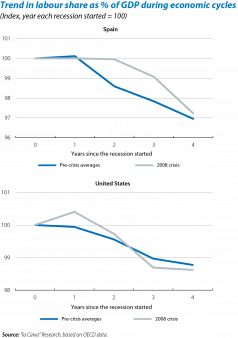The decline in the labour share in Spain and the USA: cyclical factors
As in most developed countries, the labour share in Spain is on a downward trend and this process seems to have accelerated during the last few years. Both the recessionary context and other situational factors have played a decisive role.
Apart from its overall downward trend in the long term, the labour share shows a marked procyclical pattern although it does tend to have a delayed response to variations in GDP: when a recession starts, its share normally increases but then declines sharply after a few quarters. On the other hand, the contracyclical pattern of corporate profits is also well-known. Either due to precaution, risk aversion or to improve their financial position, companies tend to increase their operating margins during recessions.
The pattern in this recession is no exception. As can be observed in the graph below, the pattern of adjustment in Spain's labour share has been quite similar to that of previous recessions. According to OECD figures, labour share declined by almost 3% between 2008 and 2012, a very similar figure to that of the last two crises. The decline in the USA's labour share, namely 1.4%, is also similar to its drop in the last few recessions.
It therefore seems reasonable to believe that, as the economic recovery consolidates, part of the decline observed in the labour income share might also recover. However, the role played by the real estate sector in the current recession might alter this pattern. The real estate sector is highly labour-intensive and this means that the labour share in relation to the sector's value added is larger than in other economic sectors. For example, in Spain the sector's labour share in relation to its value added has remained 2.5 p.p. above the ratio for the economy as a whole.
It therefore comes as no surprise that the decline in the relative weight of the building industry has been one of the main factors pushing the labour share down over the last few years. In Spain, the building industry's share of GDP fell by 5 p.p. between 2007 and 2012, down to 8.6% of GDP, and in the USA by 1.4 p.p. As can be seen in the last two graphs, the contribution by this drop in construction accounts for 60% of the decline in the labour share in the USA. In Spain, this sector's collapse would have reduced the labour share by 3.6 p.p. but it was partly offset by the increase in the share of trade and that of information and communication.
Another of the elements playing an important role in the change in the labour share is the composition of job losses. Out of the 3.6 million jobs lost between 2007 and 2013 in Spain, 2.5 were among those aged under 30. The number of employees aged over 55, however, has increased by 151,000 people. Wage differences by age group are not insignificant: in 2011, for example, the average wage for those aged over 55 was 26,000 euros per year, more than double the average wage for those under 30 and 14% more than the average wage for the population as a whole. In short, the labour share has fallen because the drop in employment has been much larger than the drop in GDP, specifically 17.7% compared with 6.9%; or, in other words, due to the marked rise in productivity that has occurred.
Moreover, if this level of productivity is maintained over the coming years, the labour share might continue to decline. This would be due to the effect of the baby boomers reaching retirement age. Such an effect cannot be underestimated: for each percentage point decrease in the share of the population over 55, even if this group's average wage remained constant, the labour income share would fall by approximately 0.1 p.p. if productivity remained constant.
In the USA, the baby boom took place about 20 years earlier than in Spain and this generation will start to reach retirement age in the next few years. Currently, most baby boomers are aged between 55 and 67, a population that has increased by about 23% since 2007 in detriment to the group aged between 25 and 54, which has decreased by 1%. Given that the older age segment has, on average, the highest wages (in 2013 these were 15% higher than the total average wage), their gradual exit from the labour market will lead to a drop in the labour share. The extent of this effect is similar to the one in Spain, namely 0.1 p.p. for every percentage point decrease in the population aged over 55, with the average wage per age group and the level of productivity remaining constant.
In summary, part of the decline in the labour income share is likely to reverse over the next few years as the economic recovery consolidates further. However, there are some factors beyond the underlying trends entailed by technological progress or globalisation which could also push the labour share downwards.
Oriol Aspachs and Ariadna Vidal
European Unit, Research Department, "la Caixa"

